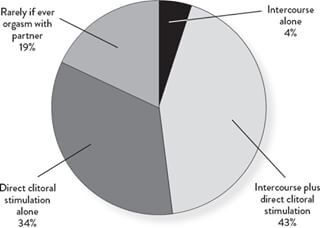Orgasm
Happy National Orgasm Day
Some information and tips to help you celebrate.
Posted July 31, 2020 Reviewed by Gary Drevitch

Today, July 31, is National Orgasm Day. To help you celebrate, below you will find a few of my favorite orgasm facts and tips—taken from my book, Becoming Cliterate—which research shows improves orgasm rate, sexual arousal, sexual satisfaction, sexual communication, and body-image in women.
1. Orgasm Explained. To understand orgasm, you first need to know that both penis- and vagina-owners have erectile tissue in their genitals. This tissue contains special capillaries that let the blood in, but not out. And, all that blood going into your erectile tissue creates tension that builds up to a very high point of tension. Orgasm is when powerful, rhythmic muscle contractions release that tension. And, stating the obvious, orgasm feels good. Here’s a description by one woman as quoted in a widely used Human Sexuality textbook:
It feels like all the tension that has been building and building is released with an explosion. It is the most pleasurable thing in the whole world.
2. Penis- and Vagina-Owners Describe Orgasm Similarly. There was a study in which people who identified as both women and men wrote descriptions of their orgasms. Expert judges (e.g., gynecologists, sex therapists) were asked to guess the sex of the writer, and they couldn’t. Both men and women talked about tension building up to a point of intensity, followed by a very pleasurable release of that tension. In explaining these similarities, the authors of The Orgasm Answer Guide pointed out that the spinal cord and brain are connected to the penis and clitoris by the same nerve route and that the clitoris originates from the same embryonic tissue as the penis. So, while the type of stimulation that gets men and women there is different, in the end, our orgasms are the same.
3. We have an "Orgasm Gap." Despite the similarities in biology and descriptions in orgasm among penis- and vagina-owners, the former are having way more orgasms than the latter. In one study, 39% of those who identified as women versus 91% of those who identified as men said they always or usually always orgasm during a sexual encounter. The main reason for this gap is that when women and men get it on, they tend to revolve the encounter around penetration and the vast majority of women do not orgasm from penetration alone. In fact, below is a chart from Becoming Cliterate showing what thousands of women say is their most reliable route to orgasm:

As you can see, among those who orgasm, 96% say their most reliable route involves some type of clitoral stimulation, either alone or coupled with penetration. Along these same lines, fewer than 1% of women say they pleasure themselves solely by penetration—also explaining why women are much more likely to orgasm when alone than with a male partner.
4. The Most Essential Step to Orgasm for Vagina-Owners. You can’t touch yourself one way during solo sex and then ignore this during partnered sex. The most crucial action needed to orgasm with a partner is to get the same type of stimulation you use when pleasuring yourself. There are two general ways to transfer your self-pleasure techniques to sex with someone else. One is teaching your partner what you like (e.g., show them, tell them). The other way is to do it yourself (e.g., using your own hands or vibrator on yourself during intercourse). And, here’s something really important about touching yourself during sex with a partner: It’s not a lesser form of sex than having your partner stimulate you. And, in fact, for some women, this is the most (or only) reliable way to reach orgasm with a partner.
5. To Have an Orgasm You Must Turn Your Brain Off. To have an orgasm, you need to switch your brain to “off mode" rather than engage in all-too-common self-monitoring (e.g., "How do I look?" "Am I going to come?"). Turning off your brain during sex can be accomplished with mindfulness, which is simply focusing completely on what is happening in the moment. When I teach students and clients about mindfulness, I tell them that being mindful is akin to riding a roller coaster, whether you like riding them or not. As you climb upward, you might be thinking to yourself “This is fun!” or “Why did I get on this thing? I want off!” But, as the roller coaster descends downhill, you become too immersed in the sensations to think any thoughts at all. This not thinking—just feeling what’s happening—is mindfulness. And it is sex’s best friend. Mindful sex is when you’re totally and completely immersed in the physical sensations of your body. It’s not a coincidence that the word mind-blowing is associated with sex. Mind-blowing sex means that your mind is not working; only your body is reacting. In fact, during orgasm, a part of the conscious mind turns off. Having an orgasm requires letting go of control and not thinking at all. That’s why studies have unequivocally shown that teaching women to be mindful leads them to be more sexually responsive and satisfied. Busy brains are not for the bedroom. So, start practicing mindfulness today, first in daily life and then in the bedroom. (I offer more detailed instructions on learning mindfulness in Becoming Cliterate and you can also learn via a free app such as Headspace or Insight Timer. Yoga is also a great way to learn mindfulness).
6. Communication is the bedrock to make your bedrock. Despite what you see in the movies, where everyone knows what to do and does it just right, in real-life sex, it's important to say what you want. It's perfectly fine to tell your partner what you like and how to pleasure you.
Happy National Orgasm Day. Come one, come all!


